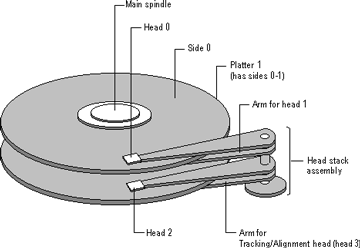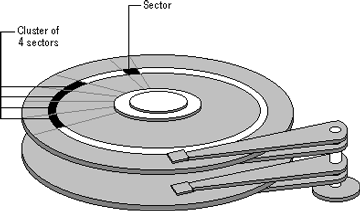A hard disk is a sealed unit containing a number of platters in a stack. Hard disks may be mounted in a horizontal or a vertical position. In this description, the hard drive is mounted horizontally. Electromagnetic read/write heads are positioned above and below each platter. As the platters spin, the drive heads move in toward the center surface and out toward the edge. In this way, the drive heads can reach the entire surface of each platter.
Each disk consists of platters, rings on each side of each platter called tracks, and sections within each track called sectors. A sector is the smallest physical storage unit on a disk, almost always 512 bytes in size.
Figure below illustrates a hard disk with two platters. The remainder of this section describes the terms used on the figure.

The cylinder/head/sector notation scheme described in this section is slowly being eliminated. All new disks use some kind of translation factor to make their actual hardware layout appear as something else, mostly to work with MS-DOS and Windows 95.
On hard disks, the data are stored on the disk in thin, concentric bands called tracks. There can be more than a thousand tracks on a 3½ inch hard disk. Tracks are a logical rather than physical structure, and are established when the disk is low-level formatted. Track numbers start at 0, and track 0 is the outermost track of the disk. The highest numbered track is next to the spindle. If the disk geometry is being translated, the highest numbered track would typically be 1023. Next figure shows track 0, a track in the middle of the disk, and track 1023.
A cylinder consists of the set of tracks that are at the same head position on the disk. In a figure below, cylinder 0 is the four tracks at the outermost edge of the sides of the platters. If the disk has 1024 cylinders (which would be numbered 0-1023), cylinder 1023 consists of all of the tracks at the innermost edge of each side.
Most disks used in personal computers today rotate at a constant angular velocity. The tracks near the outside of the disk are less densely populated with data than the tracks near the center of the disk. Thus, a fixed amount of data can be read in a constant period of time, even though the speed of the disk surface is faster on the tracks located further away from the center of the disk.
Modern disks reserve one side of one platter for track positioning information, which is written to the disk at the factory during disk assembly. It is not available to the operating system. The disk controller uses this information to fine tune the head locations when the heads move to another location on the disk. When a side contains the track position information, that side cannot be used for data. Thus, a disk assembly containing two platters has three sides that are available for data.
Each track is divided into sections called sectors. A sector is the smallest physical storage unit on the disk. The data size of a sector is always a power of two, and is almost always 512 bytes.
Each track has the same number of sectors, which means that the sectors are packed much closer together on tracks near the center of the disk. Next figure shows sectors on a track. You can see that sectors closer to the spindle are closer together than those on the outside edge of the disk. The disk controller uses the sector identification information stored in the area immediately before the data in the sector to determine where the sector itself begins.

As a file is written to the disk, the file system allocates the appropriate number of clusters to store the file's data. For example, if each cluster is 512 bytes and the file is 800 bytes, two clusters are allocated for the file. Later, if you update the file to, for example, twice its size (1600 bytes), another two clusters are allocated.
If contiguous clusters (clusters that are next to each other on the disk) are not available, the data are written elsewhere on the disk, and the file is considered to be fragmented. Fragmentation is a problem when the file system must search several different locations to find all the pieces of the file you want to read. The search causes a delay before the file is retrieved. A larger cluster size reduces the potential for fragmentation, but increases the likelihood that clusters will have unused space.
Using clusters larger than one sector reduces fragmentation, and reduces the amount of disk space needed to store the information about the used and unused areas on the disk.
The stack of platters rotate at a constant speed. The drive head, while positioned close to the center of the disk reads from a surface that is passing by more slowly than the surface at the outer edges of the disk. To compensate for this physical difference, tracks near the outside of the disk are less-densely populated with data than the tracks near the center of the disk. The result of the different data density is that the same amount of data can be read over the same period of time, from any drive head position.
The disk space is filled with data according to a standard plan. One side of one platter contains space reserved for hardware track-positioning information and is not available to the operating system. Thus, a disk assembly containing two platters has three sides available for data. Track-positioning data is written to the disk during assembly at the factory. The system disk controller reads this data to place the drive heads in the correct sector position.